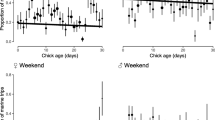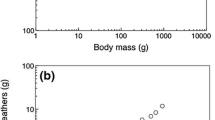Abstract
The only way a bird can obtain energy is by expending metabolic energy while foraging for food items that contain appropriate amounts and forms of energy. Birds are often specialized to use only certain kinds of food. The implication is that natural selection has shaped the morphological and physiological traits that determine the ability of a bird to obtain and process food. These general considerations, however, have not yet led to a useful predictive theory of avian foraging.
Access this chapter
Tax calculation will be finalised at checkout
Purchases are for personal use only
Preview
Unable to display preview. Download preview PDF.
Similar content being viewed by others
REFERENCES
Abrams, P. A. 1991. Life history and the relationship between food availability and foraging effort. Ecology 72:1242–1252.
Bell, G. P. 1990. Birds and mammals on an insect diet: a primer on diet composition analysis in relation to ecological energetics. Stud. Avian Biol. 13:416–422.
Boag, P. T. and P. R. Grant. 1981. Intense natural selection in a population of Darwin’s Finches (Geospizinae) in the Galápagos. Science 214:82–85.
Boag, P. T., and A. J. van Noorwijk. 1987. Quantitative genetics. In Avian Genetics, eds. F. Cooke and P. A. Buckley, pp. 45–78. Academic Press, London.
Bowman, R. I. 1961. Morphological differentiation and adaptation in the Galápagos finches. Univ. California Publ. Zool. 58:1–302.
Brooks, D. R. and D. A. McLennan. 1991. Phylogeny, Ecology, and Behavior. The University of Chicago Press, Chicago.
Bryant, D. M. and K. R. Westerterp. 1980. Energetics of foraging and free existence in birds. In Acta XVII Congressus Internationalis Ornithologici, ed. R. von Nöhring pp. 292–299. Verlag der Deutschen Ornithologen-Gesellschaft, Berlin.
Calder, W. A., III. 1984. Size, Function, and Life History. Harvard University Press, Cambridge, Massachusetts.
Caraco, T. 1980. On foraging time allocation in a stochastic environment. Ecology 61:119–128.
Caraco, T. and S. L. Lima. 1985. Foraging juncos: interaction of reward mean and variability. Anim. Behav. 33:216–224.
Charnov, E. L. 1976a. Optimal foraging: the attack strategy of a mantid. Am. Nat. 110:141–151.
Charnov, E. L. 1976b. Optimal foraging: the marginal value theorem. Theor. Pop. Biol. 9:129–136.
Crow, J. F. 1986. Basic Concepts in Population, Quantitative, and Evolutionary Genetics. W. H. Freeman, New York.
Dement, M. W. and P. J. Van Soest. 1985. A nutritional explanation for body size patterns of ruminant and non-ruminant herbivores. Am. Nat. 125:641–672.
Dunbrack, R. L. and L. A. Giguere. 1987. Adaptive responses to accelerating costs of movement: a bioenergetic basis for the type-Ill functional response. Am. Nat. 130:147–160.
Dunning, J. B., Jr. 1986. Shrub-steppe bird assemblages revisited: implications for community theory. Am. Nat. 128:82–98.
Dunning, J. B. 1990. Meeting the assumptions of foraging models: an example using tests of avian patch choice. Stud. Avian Biol. 13:462–470.
Faaborg, J. 1988. Ornithology: an Ecological Approach. Prentice-Hall, Englewood Cliffs, New Jersey.
Falconer, D. S. 1989. Introduction to Quantitative Genetics, 2nd ed, Longman, New York.
Felsenstein, J. 1985. Phylogenies and the comparative method. Am. Nat. 125:1–15.
Gass, C. L. and W. M. Roberts. 1992. The problem of temporal scale in optimization: three contrasting views of hummingbird visits to flowers. Am. Nat. 140:829–853.
Goldstein, D. L. 1990. Energetics of activity and free living in birds. Stud. Avian Biol. 13:423–426.
Goudie, R. I. and J. F. Piatt. 1991. Body size and foraging behavior in birds. In Acta XX Congressus Internationalis Ornithologici, ed. B. B. Bell et al., pp. 811–816. New Zealand Ornithological Congress Trust Board, Wellington, N.Z.
Gould, S. J. and R. C. Lewontin. 1979. The spandrels of San Marco and the Panglossian paradigm: a critique of the adaptationist program. Proc. Royal Soc. London (B) 205:581–598.
Grant, P. R. 1986. Ecology and Evolution of Darwin’s Finches. The University of Chicago Press, Chicago.
Gray, R. D. 1987. Faith and foraging: a critique of the “paradigm argument from design”. In Foraging Behavior, eds. A. C. Kamil, J. R. Krebs and H. R. Pulliam, pp. 69–140. Plenum Press, New York.
Grazal, A., S. D. Strahl, R. Parra, M. G. Dominguez, and A. Neher. 1989. Foregut fermentation in the Hoatzin, a neotropical leaf-eating bird. Science 245:1236–1238.
Greenberg, R. 1990. Ecological plasticity, neophobia, and resource use in birds. Stud. Avian Biol. 13:431–437.
Grubb, T. C., and L. Greenwald. 1982. Sparrows and a brushpile: foraging responses to different combinations of predation risk and energy cost. Anim. Behav. 30:637–640.
Harvey, P. H. and M. D. Pagel. 1991. The Comparative Method in Evolutionary Biology. Oxford University Press, Oxford.
Helfman, G. S. 1990. Mode selection and mode switching in foraging animals. Adv. Stud. Behav. 19:249–298.
Karasov, W. H. 1990. Digestion in birds: chemical and physiological determinants and ecological implications. Stud. Avian Biol. 13:391–415.
Kaspari, M. 1990. Prey preparation and the determinants of handling time. Anim. Behav. 40:118–126.
Kooyman, G. L., Y. Cherel, Y. Le Maho, J. P. Croxall, P H. Thorson, V Ridoux, and C. A. Kooyman. 1992. Diving behavior and energetics during foraging cycles in king pen-guins. Ecol. Monogr. 62:143–163.
Krebs, J. R., D. W. Stephens, and W. J. Sutherland. 1983. Perspectives in optimal foraging. In Perspectives in Ornithology, eds. A. H. Brush and G. A. Clark, Jr., pp. 165–216. Cambridge University Press, New York.
Lemon, W. C. 1991. Fitness consequences of foraging behaviour in the zebra finch. Nature 352:153–155.
Lewontin, R. C. 1979. Fitness, survival, and optimality. In Analysis of Ecological Systems, eds. D. J. Horn, R. D. Mitchell, and G. R. Stairs, pp. 3–21. Ohio State University Press, Columbus, Ohio.
Lima, S. L. 1985. Maximizing feeding efficiency and minimizing time exposed to predators: a trade-off in the black-capped chickadee. Oecologia 66:60–67.
Lima, S. L. 1987. Initiation and termination of daily feeding in dark-eyed juncos: influences of predation risk and energy reserves. Oikos 53:3–11.
Lotka, A. J. 1922a. A contribution to the energetics of evolution. Proc. Nat. Acad. Sci. (USA) 8:147–150.
Lotka, A. J. 1922b. Natural selection as a physical principle. Proc. Nat. Acad. Sci. (USA) 8:151–153.
Lotka, A. J. 1925. Principles of Physical Biology. Williams and Wilkins, Baltimore.
Ludwig, D. and L. Rowe. 1990. Life-history strategies for energy gain and predator avoidance under time constraints. Am. Nat. 135:686–707.
Mangel, M. and C. W. Clark. 1986. Towards a unified foraging theory. Ecology 67:1127–1138.
Maurer, B. A. 1980. Avian Foraging and Habitat Structure in an Eastern Deciduous Forest in West Virginia. MS thesis, West Virginia University, Morgantown.
Maurer, B. A. 1990. Extensions of optimal foraging theory for insectivorous birds: implications for community structure. Stud. Avian Biol. 13:455–461.
Maurer, B. A. and J. H. Brown. 1988. Distribution of biomass and energy use among species of North American terrestrial birds. Ecology 69:1923–1932.
Maurer, B. A. and R. C. Whitmore. 1981. Foraging of five bird species in two forests with different vegetation structure. Wilson Bull 93:478–490.
Maynard Smith, J. 1978. Optimization theory in evolution. Ann. Rev. Ecol. Syst. 9:31–56.
Maynard Smith, J. 1982. Evolution and the Theory of Games. Cambridge University Press, Cambridge.
McNamara, J. M. and A. I. Houston. 1986. The common currency for behavioral decisions. Am. Nat. 127:358–378.
Mitchell, W. A. and T. J. Valone. 1990. The optimization research program: studying adaptations by their function. Q. Rev. Biol. 65:43–52.
Morse, D. H. 1971. The insectivorous bird as an adaptive strategy. Ann. Rev. Ecol. Syst. 2:177–200.
Myers, J. P. 1983. Commentary. In Perspectives in Ornithology, eds. A. H. Brush and G. A. Clark, Jr., pp. 216–221. Cambridge University Press, New York.
Nagy, K. A. 1987. Field metabolic rate and food requirement scaling in mammals and birds. Ecol. Monogr. 57:111–128.
Nagy, K. A. and B. S. Obst. 1991. Body size effects on field energy requirements of birds: what determines their field metabolic rates? In Acta XX Congressus Internationalis Ornithologici, ed. B. B. Bell et al., pp. 793–799. New Zealand Ornithological Congress Trust Board, Wellington, N.Z.
Nonacs, P. and L. M. Dill. 1993. Is satisficing an alternative to optimal foraging theory? Oikos 67:371–375.
Orians, G. H. and N. E. Pearson. 1979. On the theory of central place foraging. In Analysis of Ecological Systems, eds. D. J. Horn, R. D. Mitchell, and G. R. Stairs, pp. 155–177. Ohio State University Press, Columbus.
Orr, H. A. and J. A. Coyne. 1992. The genetics of adaptation: a reassessment. Am. Nat. 140:725–742.
Osterhaus, O. B. 1962. Adaptive modifications in the leg structure of some North American warblers. Am. Midl Nat. 68:474–486.
Parker, G. A. and J. Maynard Smith. 1990. Optimality theory in evolutionary biology. Nature 348:27–33.
Pennycuick, C. J. 1975. Mechanics of flight. In Avian Biology, vol. 5, eds. D. S. Farner and J. R. King, pp. 5–17. Academic Press, New York.
Peters, R. H. 1983. The Ecological Implications of Body Size. Cambridge University Press, Cambridge.
Pierotti, R., and C. A. Annett. 1991. Diet choice in the herring gull: constraints imposed by reproductive and ecological factors. Ecology 72:319–328.
Price, T., M. Kirkpatrick, and S. J. Arnold. 1988. Directional selection and the evolution of breeding date in birds. Science 240:798–799.
Pulliam, H. R. 1974. On the theory of optimal diets. Am. Nat. 108:59–75.
Pulliam, H. R. 1975. Diet optimization with nutrient constraints. Am. Nat. 109:765–768.
Pulliam, H. R. 1980. Do chipping sparrows forage optimally? Ardea 68:75–82.
Pyke, G. H. 1984. Optimal foraging theory: a critical review. Ann. Rev. Ecol Syst. 15:523–575.
Pyke, G. H., H. R. Pulliam, and E. L. Charnov. 1977. Optimal foraging: a selective review of theory and tests. Q. Rev. Biol 52:137–154.
Raphael, M. G. and B. A. Maurer. 1990. Biological considerations for study design. Stud. Avian Biol 13:123–125.
Remsen, J. V., Jr. and S. K. Robinson. 1990. A classification scheme for foraging behavior of birds in terrestrial habitats. Stud. Avian Biol 13:144–160.
Richman, A. D. and T. Price. 1992. Evolution of ecological differences in the Old World leaf warblers. Nature 355:817–821.
Robbins, C. T. 1983. Wildlife Feeding and Nutrition. Academic Press, New York.
Rudolph, S. G. 1982. Foraging strategies of American kestrels during the breeding season. Ecology 63:1268–1276.
Schoener, T. W. 1971. Theory of feeding strategies. Ann. Rev. Ecol. Syst. 2:369–404.
Schoener, T. W. 1987. A brief history of optimal foraging theory. In Foraging Behavior eds. A. C. Kamil, J. R. Krebs, and H. R. Pulliam, pp. 5–67. Plenum Press, New York.
Sherry, T. W. 1990. When are birds dietarily specialized? Distinguishing ecological from evolutionary approaches. Stud. Avian Biol. 13:337–353.
Speakman, J. R. 1987. Apparent absorption efficiencies for redshank (Tringa totanus L.) and oystercatcher (Haematopus ostralegus L.): implications for the predictions of optimal foraging models. Am. Nat. 130:677–691.
Stalmaster, M. V and J. A. Gessaman. 1984. Ecological energetics and foraging behavior of overwintering bald eagles. Ecol Monogr. 54:407–428.
Stearns, S. C. 1992. The Evolution of Life Histories. Oxford University Press, Oxford.
Stephens, D. W. 1990. Foraging theory: up, down, and sideways. Stud. Avian Biol. 13:444–454.
Stephens, D. W. and E. L. Charnov. 1982. Optimal foraging: some simple stochastic models. Behav. Ecol Sociobiology 10:251–263.
Stephens, D. W. and J. R. Krebs. 1986. Foraging Theory. Princeton University Press, Princeton, New Jersey.
Walsberg, G. E. 1983. Avian ecological energetics. In Avian Biology, vol. 7, eds. D. S. Farner, J. R. King, and K. C. Parkes, pp. 161–220. Academic Press, New York.
Ward, D. 1992. The role of satisficing in foraging theory. Oikos 49:188–125.
Ward, D. 1993. Foraging theory, like all other fields of science, needs multiple working hypotheses. Oikos 67:376–378.
Watt, W. B. 1985. Bioenergetics and evolutionary genetics: opportunities for a new synthesis. Am. Nat. 125:118–143.
Wiens, J. A. 1976. Population responses to patchy environments. Ann. Rev. Ecol Syst. 7:81–120.
Yang, S. Y. and J. L. Patterson, 1981. Genie variability and differentiation in the Galápagos finches. Auk 98:230–242.
Valone, T. J., and S. L. Lima. 1987. Carrying food items to cover for consumption: the behavior of ten bird species under the risk of predation. Oecologia 71:286–294.
Editor information
Editors and Affiliations
Rights and permissions
Copyright information
© 1996 Chapman & Hall
About this chapter
Cite this chapter
Maurer, B.A. (1996). Energetics of Avian Foraging. In: Carey, C. (eds) Avian Energetics and Nutritional Ecology. Springer, Boston, MA. https://doi.org/10.1007/978-1-4613-0425-8_8
Download citation
DOI: https://doi.org/10.1007/978-1-4613-0425-8_8
Publisher Name: Springer, Boston, MA
Print ISBN: 978-1-4613-8046-7
Online ISBN: 978-1-4613-0425-8
eBook Packages: Springer Book Archive




